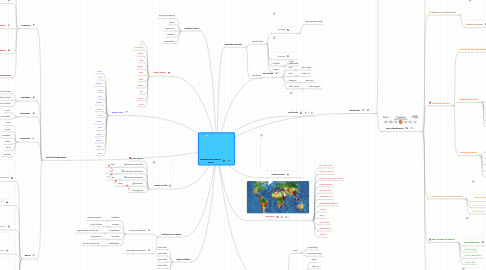
1. Trophic Levels
1.1. Decomposer
1.2. Tertiary Consumer
1.2.1. 1/10%
1.3. Secondary Consumer
1.3.1. 1%
1.4. Primary Consumer
1.4.1. 10%
1.5. Producer
1.5.1. 100%
1.6. Energy(Sun)
2. Levels of Organization
2.1. Organism
2.1.1. Producer
2.1.1.1. Grass
2.1.1.2. Algae
2.1.1.3. Trees
2.1.1.4. Weeds
2.1.2. Primary Consumer
2.1.2.1. Deer
2.1.2.2. Krill
2.1.2.3. Giraffe
2.1.2.4. Duck
2.1.3. Secondary Consumer
2.1.3.1. Wolf
2.1.3.2. Whale
2.1.3.3. Leapard
2.1.3.4. Fox
2.1.4. Tertiary Consumer
2.1.4.1. Bear
2.1.4.2. Killer Whale
2.1.4.3. Lion
2.1.4.4. Mountain Lion
2.1.5. Decomposers
2.1.5.1. Fungi
2.1.5.2. Bacteria
2.1.5.3. Dung Beetle
2.1.5.4. Worm
2.2. Population
2.2.1. Herd of Sheep
2.2.2. School of Fish
2.2.3. Pack of Wolves
2.3. Community
2.3.1. Farm
2.3.2. Coral Reef
2.4. Ecosystem
2.4.1. Arctic
2.4.2. Forest
2.4.3. Grassland
2.4.4. Ocean
2.4.5. Pond
2.4.6. Wetland
2.5. Biome
2.5.1. Coniferous Forest
2.5.2. Desert
2.5.3. Freshwater
2.5.4. Marine
2.5.5. Rainforest
2.5.6. Savannah
2.5.7. Temperate Deciduous Forest
2.5.8. Tundra
3. Biotic Factor
3.1. Acorn
3.2. Cat
3.3. Corpse
3.4. Dog
3.5. Fish
3.6. Flower
3.7. Grass
3.8. Hair
3.9. Human
3.10. Leaf
3.11. Lizard
3.12. Mouse
3.13. Paper
3.14. Tree
4. Abiotic Factor
4.1. Air
4.2. Aluminum
4.3. Glass
4.4. Heat
4.5. Plastic
4.6. Sand
4.7. Steel
4.8. Stone
4.9. Sun
4.10. Water
4.11. Wind
5. Ecological Succession
5.1. Primary Succession
5.1.1. Nudation
5.1.1.1. Pioneer Species
5.1.2. Invasion
5.1.2.1. Small Shrubs
5.1.3. Competition
5.1.3.1. Large Bushes and Shrubs
5.1.4. Reaction
5.1.4.1. Young Trees
5.1.5. Stabilization
5.1.5.1. Climax Community
5.2. Secondary Succession
6. Limiting Factors
6.1. Carrying Capacity
6.2. Space
6.3. Resources
6.4. Disease
6.5. Temperature
7. Water Pollution
7.1. New node
7.2. New node
7.3. New node
7.4. New node
7.5. New node
8. Food Web
9. Food Chain
9.1. Algae
9.2. Krill
9.2.1. Eats Algae
9.3. Fish
9.3.1. Eats Krill
9.4. Penguin
9.4.1. Eats Fish
9.5. Killer Whale
9.5.1. Eats Penguin
10. Biodiversity
10.1. Levels
10.1.1. Genetic Biodiversity
10.1.2. Species Biodiversity
10.1.3. Ecosystem Biodiversity
10.2. Loss of Biodiversity
10.2.1. Extinct Species
10.2.1.1. Dodo
10.2.1.2. Tyrannosaurus
10.2.1.3. Passenger Pigeon
10.2.1.4. Dimetrodon
10.2.1.5. Caribbean Monk Seal
10.2.2. Extinct in the Wild Species
10.2.2.1. Alagoas Curassow
10.2.3. Threatened Species
10.2.3.1. Critically Endangered Species
10.2.3.1.1. Javan Rhino
10.2.3.1.2. Arakan Forest Turtle
10.2.3.1.3. Brazilian Merganser
10.2.3.1.4. Gharial
10.2.3.2. Endangered Species
10.2.3.2.1. Siberian Tiger
10.2.3.2.2. Blue Whale
10.2.3.2.3. Giant Panda
10.2.3.2.4. Albatross
10.2.3.2.5. Snow Leopard
10.2.3.3. Vulnerable Species
10.2.3.3.1. Cheetah
10.2.3.3.2. Lion
10.2.3.3.3. Polar Bear
10.2.3.3.4. Manatee
10.2.3.3.5. Wolverine
10.2.4. Conservation Dependent Species
10.2.4.1. Leopard Shark
10.2.4.2. Black Caiman
10.2.4.3. Spotted Hyena
10.2.5. Near Threatened Species
10.2.5.1. Blue-Billed Duck
10.2.5.2. Solitary Eagle
10.2.5.3. Small-Clawed Otter
10.2.5.4. Maned Wolf
10.2.6. Least Concern Species
10.2.6.1. Wood Pigeon
10.2.6.2. Harp Seal
10.2.6.3. Nootka Cypress
11. Hot Spots
11.1. US West Coast
11.2. Central America
11.3. South America West Coast
11.4. Mediterranean
11.5. Horn of Africa
11.6. South East Asia
11.7. Indonesia/Philippines
11.8. Amazon
11.9. Japan
11.10. South Africa
11.11. New Zealand
11.12. Oceania
12. Indicator Species
12.1. Uses
12.1.1. Prospecting
12.1.2. Forestry Surveys
12.2. Examples
12.2.1. Puffin
12.2.2. Gray Jay
12.2.3. Amphibians
12.2.4. Mayflies
12.2.5. Lichens
12.3. Types
12.3.1. Air Quality
12.3.2. Water Pollution
12.3.3. Climate Change
13. Population Growth
13.1. Growth Rate
13.1.1. J-Curve
13.1.1.1. Exponential Growth
13.1.2. S-Curve
13.1.3. Highest
13.1.3.1. New node
13.1.4. Lowest
